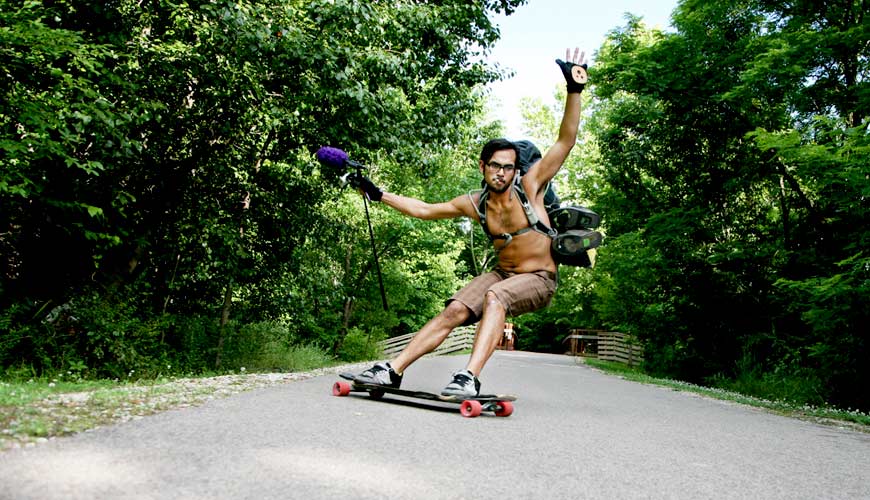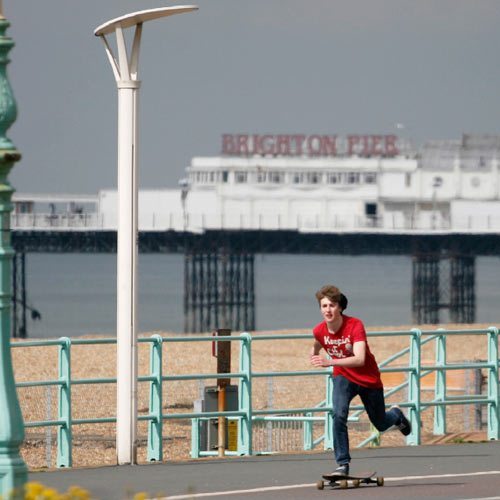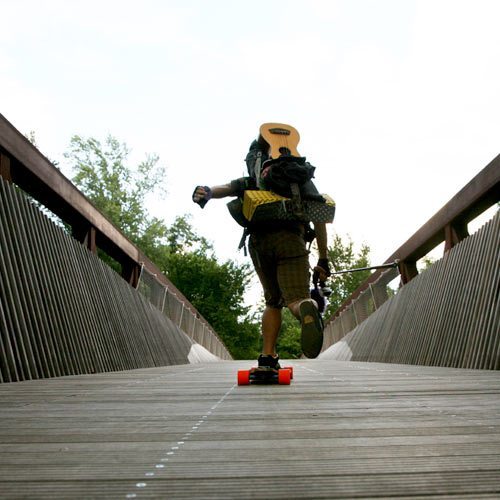
Defining longboarding’s purpose isn’t easy. Some will say it’s a tool for fun, for thrills, for commuting. Or perhaps it’s a vehicle for pushing one’s boundaries and even finding one’s self atop the humble plank and four wheels. All are legitimate purposes, though, and their pursuit produces a common byproduct: exploration.
Skating through countries and foreign lands, spending weeks or even months on the road, has become a proving ground for countless skaters. So if you’re planning a long trek, take some pointers from those who’ve done it before. A combination of grit and knowing what to expect will help ensure you reach that faraway destination, even when it’s a long road ahead. When facing such a trek, what should you bring? The essentials resemble a camping list, especially for Darrian Balongie. Balongie skated 3,700 miles across the U.S. from New York City to San Diego during the summer of 2013. To honor a young cousin who passed away from leukemia before his first birthday, Balongie made the trek to raise money for St. Jude Children’s Research Hospital in Memphis, Tennessee, where his cousin had received care.
While it’s a weighty requirement, bring a sizeable water bottle. Balongie carried a four-liter bottle that at times still left him dry. In the desert in Arizona, where the sun’s rays beat down with 103 degrees of fury, Balongie faced a long uphill climb. Lacking water, he knew he wouldn’t make the ascent. He posted up by the side of the road, leaning on a guardrail, waiting for someone, anyone, to pass by. Eventually, a car stopped and someone gave him some sparkling water. “It was like the best thing I’ve ever drank, and I hate sparkling water,” Balongie says.
After being worn out from all the skating, bring a tent that’s lightweight and simple to construct and take down. You can plan stops at some campsites, but if not, you can do what Balongie did: simply veer off the road and camp in a wooded or otherwise suitable area for the night.
Balongie once woke to a coyote around his tent, and Jack Courtenay, who  skated north to south across Japan in the summer of 2013, once heard a wolf howling near his tent. So stay aware in remote areas, and make sure you can make a quick fold-and-go with the tent. Courtenay’s trek across Japan raised money for children left orphaned by the country’s massive 2011 tsunami disaster. A native of Auckland, New Zealand, it was his first time to Japan. “It just seemed a lot better than coming to Japan as a typical tourist,” Courtenay says.
skated north to south across Japan in the summer of 2013, once heard a wolf howling near his tent. So stay aware in remote areas, and make sure you can make a quick fold-and-go with the tent. Courtenay’s trek across Japan raised money for children left orphaned by the country’s massive 2011 tsunami disaster. A native of Auckland, New Zealand, it was his first time to Japan. “It just seemed a lot better than coming to Japan as a typical tourist,” Courtenay says.
Beyond practicalities, consider what will be useful particularly for your needs; think outside of that camping list. Balongie carried a dry bag for electronics, and Courtenay had a translator device to navigate the Japanese language. Courtenay also carried a letter in Japanese explaining his journey’s purpose and fundraising – a token that, when read by strangers, often earned him their support and even free meals or a chance to rest up at their homes. Balongie carried a Kala U-bass, a ukulele-sized acoustic bass that was lightweight and perfect for passing the time on long, flat roads. When tired, he’d even sit on gas-station curbs and play for pocket change. Was it an essential item?
Probably not. But there’s value in any item that helps you keep motivated, stay sane and have fun. Physical conditioning is also important, and preparing your body for a long-distance skate requires a bit more than that 30-second stretch session you usually forgo anyway. A month before his departure, Courtenay started hitting the gym, and he’d skate to a nearby city and back for practice. Balongie would skate 30 miles a day to prep.
Yet even with conditioning, if you’re taking a backpack, it’ll likely prove the biggest burden. Courtenay says that at the end of his first day, he couldn’t even shoulder the weight of his backpack, but that his body soon adjusted. Balongie also had a load on his back. “Had I not had a backpack on, I probably wouldn’t have been sore at all.” That said, you’re probably not used to skating with a heavy backpack, so fill it up now and get those shoulders prepared.
Travel agents don’t specialize in cross-country skate treks, so planning your trip is up to you. It’s also a bit different than planning a road trip, so instead of gas stations, you’ll want to make sure you have stops for water and food planned out. While the country or area you’ll be skating through is one factor, planning relies on the basic premise of looking for cities and lining them up. “I planned the whole route at once,” Balongie says. “I just looked at major cities and connected the dots.”
Connor Smith also diligently preplanned the route for his skate between Plymouth Hoe and Brighton Pier in England. He made the journey to raise money for Great Ormond Street Hospital in London, where he’d had surgery to remove a tumor behind his left eye caused by a rare condition called Langerhans cell hystiosis, or LCH. He says his journey was the least he could do for the hospital that saved his life. Since some roads along the English countryside weren’t conducive to skating, he’d ride ahead in a support car at times to preview the route before skating.
Courtenay says he had a brief idea of which roads he’d take across Japan – and fortunately, the road signs were typically in English and Japanese – but relied on Google Maps to keep him on track.
You might think the last days of the journey would be the worst, with aching muscles and a worn longboard. Yet it’s the first days that often prove the hardest. The country roads of Plymouth were a constant uphill battle for Smith, as was the heat wave rolling through England’s countryside. “I thought, bloody hell, if I’ve got another nine days of this …” he says. “But actually it did get better after that.” Balongie reported similar trepidations starting out. “I was very intimidated at first, but after the second or third day I was like, ‘Man, I got this,’” he says. “When it was fun, it was really fun. When it was work, it was a lot of work.”
Even if you realize that the first few days could be the toughest, you’ll likely  need more motivation to push through to the end. This is where having a higher purpose for your journey can help. It’s no coincidence that longboard treks are so often paired with raising money or awareness – or both – for a cause, a cause that empowers and motivates when the road gets tough.
need more motivation to push through to the end. This is where having a higher purpose for your journey can help. It’s no coincidence that longboard treks are so often paired with raising money or awareness – or both – for a cause, a cause that empowers and motivates when the road gets tough.
You know that a long day of longboarding will leave you hungry. But consider that how you fuel up will affect how far you go. Even if you’re relying on snacks in your backpack or from gas stations at times, keep some nutrition pointers in mind. “Sixty to 65% percent of your daily calories should come from good complex carbohydrates. They should be the foundation of your meal,” says Elaine Hastings, a Florida-based dietitian and sports nutritionist who has worked with Olympic gold medalists and other professional athletes. She also recommends laying off the refined sugars and avoiding too much caffeine to prevent crashing (nutritionally speaking, that is), and hydrating by alternating between water and a sports drink.
Even if it’s an energy bar or other backpack snack, eat something with carbs and protein within 15–30 minutes of finishing skating to avoid dipping into reserved energy and potentially losing muscle, Hastings says. Plan to have a full meal within an hour or two after a session.
When preparing for your skate, get your diet in shape too. “You want to do in preparation and training what you’re going to do for your trek,” Hastings says, so eat the same beforehand as you plan to on the road. She recommends getting your diet in synch at least a month from your start, if not two or three months out. “If you don’t have the nutrition behind what you’re doing, your body’s not going to work for you.”
Preparation for a long trek remains essential. Yet experience will be your best resource, and every day on the road, every push, will mean more experience. Advice can’t replace experience, but when you’re starting out, it’s an asset best not overlooked. Prepare wisely, and keep on pushing.
Thankyou Michael Brooke, and Concrete Wave Magazine.
